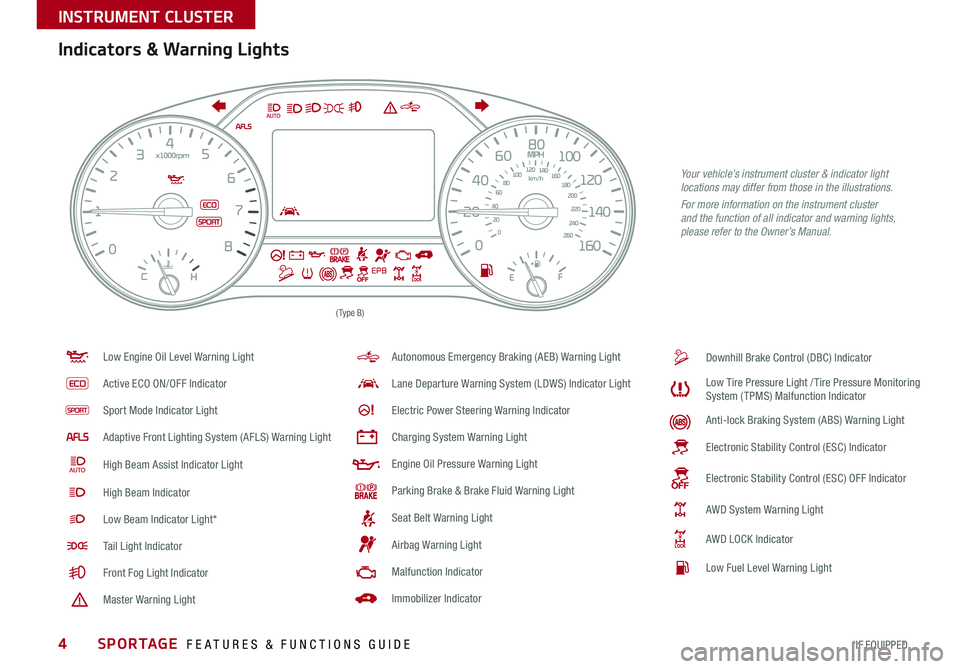ABS KIA SPORTAGE 2017 Features and Functions Guide
[x] Cancel search | Manufacturer: KIA, Model Year: 2017, Model line: SPORTAGE, Model: KIA SPORTAGE 2017Pages: 50, PDF Size: 2.73 MB
Page 6 of 50

SPORTAGE FEATURES & FUNCTIONS GUIDE4*IF EQUIPPED
INSTRUMENT CLUSTER
Your vehicle’s instrument cluster & indicator light locations may differ from those in the illustrations.
For more information on the instrument cluster and the function of all indicator and warning lights, please refer to the Owner’s Manual.
(Type B)
Indicators & Warning Lights
Low Engine Oil Level Warning Light
Active ECO ON/OFF Indicator
Sport Mode Indicator Light
Adaptive Front Lighting System (AFLS) Warning Light
High Beam Assist Indicator Light
High Beam Indicator
Low Beam Indicator Light*
Tail Light Indicator
Front Fog Light Indicator
Master Warning Light
Autonomous Emergency Braking (AEB) Warning Light
Lane Departure Warning System (LDWS) Indicator Light
Electric Power Steering Warning Indicator
Charging System Warning Light
Engine Oil Pressure Warning Light
Parking Brake & Brake Fluid Warning Light
Seat Belt Warning Light
Airbag Warning Light
Malfunction Indicator
Immobilizer Indicator
Downhill Brake Control (DBC) Indicator
Low Tire Pressure Light / Tire Pressure Monitoring System ( TPMS) Malfunction Indicator
Anti-lock Braking System (ABS) Warning Light
Electronic Stability Control (ESC) Indicator
Electronic Stability Control (ESC) OFF Indicator
AWD System Warning Light
AWD LOCK Indicator
Low Fuel Level Warning Light
Page 7 of 50

5ALWAYS CHECK THE OWNER’S MANUAL FOR COMPLETE OPERATING INFORMATION AND SAFETY WARNINGS. *IF EQUIPPED
INSTRUMENT CLUSTER
Fuel Economy
There are several factors that contribute to your
vehicle’s fuel economy, including maintenance of
your vehicle, driving style, environmental conditions,
vehicle weight and vehicle aerodynamics. Below are
tips on how to help improve fuel economy:
•Keep your vehicle in good condition with
regular maintenance
•Don’t let the engine idle longer than necessary
•Drive at a moderate speed, accelerating
smoothly and at a moderate rate
•Keep tires inflated to the recommended pressure
•Travel lightly, without carrying unnecessary
weight in your vehicles
•Avoid placing large or heavy items on roof racks
•Avoid hilly, winding or poorly maintained roads
REMINDER: Driving range varies depending on a vehicle’s fuel tank size, e.g., 12-gal. vs. 24-gal. Even though the two vehicles' MPG may be the same, the vehicle with the larger tank will have the greater range.
For more information on Fuel Economy, you can snap the QR Code to the right to view a video or refer to the brochure, "GETTING MORE OUT OF EVERY GALLON, FUEL-SAVING TIPS TO DRIVE BY" available at your local dealership.
Downhill Brake Control (DBC) Indicator
Low Tire Pressure Light / Tire Pressure Monitoring System ( TPMS) Malfunction Indicator
Anti-lock Braking System (ABS) Warning Light
Electronic Stability Control (ESC) Indicator
Electronic Stability Control (ESC) OFF Indicator
AWD System Warning Light
AWD LOCK Indicator
Low Fuel Level Warning Light
The TPMS indicator
functions as both Low
Tire Pressure Light and TPMS
Malfunction Indicator.
The indicator will illuminate if
one or more tires is significantly
underinflated, the vehicle has a spare tire installed without TPMS
or the outside temperature becomes significantly lower.
The Low Tire Pressure Position Indicator A is displayed on the
LCD screen in the instrument cluster when one or more of your
tires are underinflated.
Inflate tire(s) to specifications using an accurate digital tire
pressure gauge to turn off Low Tire Pressure Light and Low Tire
Pressure Position Indicator A. See front driver’s door jamb for
PSI specification.
When there is a problem with the TPMS, the TPMS Malfunction
Indicator will blink for approximately one minute and then
illuminate. See dealer for service.
REMINDER: Consult your dealer for service if Low Tire Pressure Light remains illuminated after inflating your tire(s).
Tire Pressure Monitoring System (TPMS) To view these videos on your mobile device, snap these QR Codes or visit the listed website.
Refer to page 2 for more information.
Fuel Economy Video
Tire Pressure Monitoring System
www.KuTechVideos.com/ql13/2017
www.KuTechVideos.com/ql13/2017
QR CODES
•
•Even with TPMS, tire pressure should be checked manually at least once a month. Only adjust tire pressure on “cold tires” •For proper maintenance and optimal fuel economy, maintain recommended tire inflation pressures and stay within the load limits and weight distribution recommended for your vehicle •In winter or cold weather, the TPMS light may illuminate if the tire pressure was adjusted to the recommended tire inflation pressure during warm weather
QUICK TIPS
A